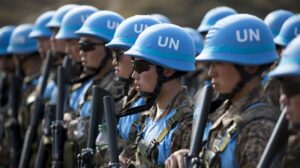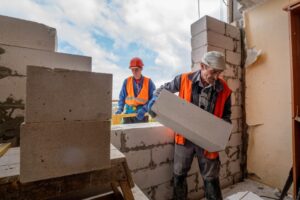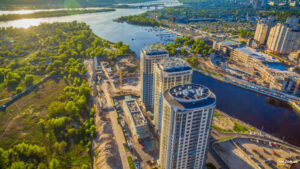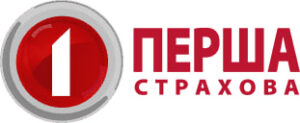
German newspaper Die Welt, citing EU diplomats, reports that Chinese authorities have confirmed their readiness to participate in a peacekeeping contingent for Ukraine.
However, it is emphasized that the government in Beijing will be ready to do so “if the peacekeepers are deployed on the basis of a United Nations mandate.”
“In Brussels, Beijing’s plan has met with a mixed reaction. On the one hand, it is said that the inclusion of countries from the Global South, such as China, could make the deployment of foreign troops for peace monitoring more acceptable,” Die Welt writes.
“However, on the other hand,” the publication continues, “there is also a danger that China will primarily want to spy on Ukraine and take a clearly pro-Russian position instead of a neutral one in the event of a conflict,” said a senior EU diplomat familiar with the ongoing discussions.

Installment plans with extended repayment terms offered by developers are in high demand among homebuyers and are an alternative to government mortgage programs, Ukrainian developers told Interfax-Ukraine.
“In 2024-2025, we are seeing growth in the share of customers who choose long-term interest-free installment plans from KAN Development. This is due to increased buyer confidence in the future, especially given the improved security situation in Kyiv. The eOselya and eVidnovuvannya programs have had a limited impact on our sales so far. Most customers choose other financial solutions, in particular our own programs,” said the KAN Development press service.
In recent years, there has been a growing demand for longer installment plans, noted Irina Mikhaleva, SMO Alliance Novobud. In addition, developers are offering programs with reduced down payments.
“At the start of construction, we can offer longer installment plans—12, 24, or 36 months. This is because, as a rule, installment plans are provided until the project is commissioned. We also frequently receive requests from buyers to reduce the down payment, which can be anywhere from 10% to 50%,” said the expert.
The Kovalskaya Group’s internal installment plans offer a fixed price per square meter for up to five years with a down payment of 30% of the property value. According to the company, they take an individual approach to buyers’ needs.
“Installment plans have become more flexible: if a customer realizes that they will not be able to make monthly payments, we are open to dialogue and ready to work together to find a convenient solution. It is possible to agree on an individual schedule, for example, to extend the installment period, temporarily reduce the amount of payments with a subsequent return to standard payments, restructure the loan, or exchange the apartment for another of the same size or in another construction project,” explained the developer.
The company “RIEL” in the second launch complex of the capital’s Brother project offers buyers the opportunity to purchase housing in installments until the facility is put into operation in the second quarter of 2028, noted Alla Chipak, sales coordinator at “RIEL” in Lviv. In addition, in some residential complexes, the down payment has been reduced to 10% of the apartment price.
Given the popularity of the developer’s renovation option, Intergal-Bud also offers the possibility of paying for renovations in installments along with the apartment, said Anatoly Kovrizhenko, deputy commercial director of Intergal-Bud.
According to the DIM group of companies, developer lending programs with extended installment terms are an alternative to state mortgage programs with loan limits. The company has its own financial programs, under which the down payment is 30% of the cost of the property, and the installment period is up to five years.
In addition, DIM offers a long-term installment plan of up to 10 years.
“In early June, we launched a long-term installment plan in hryvnia for a period of 10 years, with the option of early repayment, price fixing in hryvnia, fixing the price per square meter in the contract, without linking it to the exchange rate or market price increases, with a fixed interest rate of 10% per annum in hryvnia and a down payment of 30%. It was planned to launch as a pilot project for two months, testing it in large residential complexes such as Metropolis, Lucky Land, and Park Lake City. However, we received quite a few inquiries from buyers, which turned into real deals, so we continued the program until the end of the summer,” said Alexander Nasirovsky, managing partner of DIM.

Canadian Prime Minister Mark Trudeau announced on Friday that the Canadian authorities are waiving a number of tariffs imposed in response to US tariffs on some US imports, according to The Globe and Mail.
“In accordance with our commitments under the United States-Mexico-Canada Agreement (USMCA), I am announcing today that the Canadian government will take measures similar to those taken earlier by the US and will remove tariffs on all US goods covered by the agreement,” the prime minister said.
However, Carnie clarified that Canada will maintain tariffs on US imports of steel, aluminum, and automobiles, and Ottawa will work intensively with Washington on this issue. Carney noted that following his conversation with US President Donald Trump this week, the two sides will engage in more active discussions on “challenges in strategic sectors” and on increasing cooperation in trade, investment, and security.
Carney also believes that Canada is making progress in trade negotiations with the US. “Canada currently has the best trade agreement with the US, and although it is different from what it was before, it is still better than any other country’s,” the prime minister said.
On August 1, Trump signed an executive order raising tariffs on Canada from 25% to 35%. The statement emphasized that goods covered by the preferential tariff regime under the USMCA remain exempt from the new tariffs.
In turn, The Globe and Mail reminds us that Ottawa is seeking an agreement that would reduce or eliminate tariffs on a number of Canadian goods. In July, Carnie acknowledged that Canada would probably not be able to convince Trump to cancel all tariffs.
At the same time, Canada implemented three rounds of retaliatory measures against the US. In the first round, it imposed 25% tariffs on US products worth $30 billion, including motorcycles and orange juice. The second round included 25% tariffs on another $30 billion worth of products, including metal products and consumer goods. The third round included 25% tariffs on cars, except for companies that have production facilities in Canada.
However, the publication notes that Canada subsequently softened the impact of the tariffs by approving certain exemptions, including for US-produced raw materials and components used in Canadian manufacturing.

The Supreme Court has ruled to terminate the private company’s right to own the embankment in the Berkovshchyna area, near the residential complex at 14 Dniprovska Embankment in the Darnytskyi district of Kyiv, according to the press service of the Kyiv City Prosecutor’s Office.
“This concerns the embankment near the residential complex at 14 Dniprovska Embankment Street in the Darnytskyi district of the capital. The owners of the hydraulic structures installed barriers and gates, blocking access to the river for people who want to walk there but do not live in the residential complex,” the press release said.
The River Stone residential complex is located at the specified address.
It is noted that the hydraulic structures in the form of an embankment with an area of almost 500 square meters serve as protection against erosion and are located on a communal land plot of the water fund with an area of over 3.1 hectares worth over UAH 67 million within the coastal protection strip of the Dnipro River.
At the same time, a private company registered ownership of the specified hydraulic structures, which threatened the removal of the land from the ownership of the territorial community and created restrictions on the access of Kyiv residents to the Dnipro embankment, the statement said.
“The Supreme Court agreed with the prosecutor’s arguments: ownership of a hydraulic structure cannot be registered to anyone. Thus, the court put an end to this case – access to the Dnipro embankment must be available to everyone, not just residents of one residential complex,” the prosecutor’s office concluded.
According to activist Oleg Symoroz, on August 22, the dismantling of the fence blocking access to the embankment began near the River Stone residential complex. After that, unknown persons began to restore the brick fence.
“In the Darnytskyi district of the capital, on the embankment near the River Stone residential complex, thugs are erecting a new wall that restricts free access for citizens. I remind you that the Supreme Court of Ukraine has ordered that free access for citizens be ensured on the embankment,” he said.
The construction of the River Stone business-class residential complex in the Darnytskyi district of the capital began in 2010. The project consists of nine 23-story buildings, the last of which was commissioned in 2021. The developer of the residential complex is UDP, the general contractor is Miskzhytlobud Construction Company LLC, and the customer is Livoberezhzhya Plus LLC.
According to LUN, the permit for construction work was issued in 2011, with amendments made to the document in 2017 and 2020.
Source: https://interfax.com.ua/news/general/1098583.html
Dnipro embankment, River Stone residential complex, SUPREME COURT

In January-June 2025, PJSC Insurance Company Persha (Kyiv) collected UAH 666.9 million in gross premiums, which is 29.3% more than in the first half of last year, and UAH 622.5 million in net premiums (+29.5%), according to the rating agency Standard-Rating in its information on the confirmation of the company’s credit rating/financial stability rating at the level of “uaAA” on the national scale based on the results of the specified period.
In particular, income from individuals grew by 41.91% to UAH 262.406 million, and from reinsurers by 9.84% to UAH 1.730 million. The share of individuals in the insurer’s gross premiums reached 39.35%.
Insurance payments sent to reinsurers in the first half of 2025 increased by 26.99% compared to the same period in 2024, to UAH 44.364 million, The reinsurers’ share in insurance premiums decreased by 0.12 percentage points (pp) to 6.65%.
In January-June 2025, IC Persha paid its clients UAH 291.001 million in insurance payments and reimbursements, which is 39.75% higher than the amount of payments for the same period in 2024.
Thus, the payout ratio increased by 3.26 p.p. to 43.64%.
The insurer’s operating profit for the reporting period increased to UAH 26.601 million, and net profit to UAH 36.134 million.
As of July 1, 2025, the company’s assets grew by 17.51% to UAH 1.291 billion, equity increased by 20.33% to UAH 302.655 million, liabilities increased by 16.68% to UAH 988.597 million, cash and cash equivalents increased by 27.62% to UAH 292.168 million.
The agency notes that as of the reporting date, IC Persha had formed a portfolio of current financial investments in bank deposits in the amount of UAH 57.125 million, which together with cash and cash equivalents covered 35.33% of its liabilities.
PJSC Insurance Company Persha has been operating in the Ukrainian insurance market since 2001. The company specializes in motor insurance. IC Persha is a member of the Motor Insurers’ Bureau of Ukraine, the League of Insurance Organizations of Ukraine, and the National Insurer of International Road Transport Documents (TIR).

In the industrial park (IP) “Western Ukrainian Industrial Hub” (Ternopil region), the Babusya Marusya food factory, which produces canned vegetables, pickles, and semi-finished products from vacuum-packed vegetables, has begun shipping its products, according to Dmytro Kysilevsky, deputy chairman of the Verkhovna Rada Committee on Economic Development.
“The plant has already reached its design production capacity and plans to produce 650 tons of canned goods in 2025,” he wrote on Facebook.
According to the MP, the investment made by PJSC “Agroprodservice” (Nastasiv, Ternopil region) in the launch of the plant amounted to UAH 45 million.
The construction of industrial premises with a total area of 1,700 square meters and the installation of production lines lasted from 2024 to 2025. The enterprise has created 30 jobs, and plans to increase its staff by 50% in the near future. The plans include establishing export supplies to the Baltic countries, Israel, Turkey, and Italy.
The Western Ukrainian Industrial Hub, covering an area of over 10 hectares, was established in 2022 on the site of a meat processing plant that had been out of operation for over 10 years but retained its powerful engineering and logistics infrastructure. Currently, the park has more than 58,000 square meters of renovated industrial premises with ceilings 5-10 meters high and its own 10 MW substation.
In addition to the Babusia Marusia plant, the Western Ukrainian Industrial Hub industrial park is home to the companies Nasha Ptytsia (chicken processing), Delta Food (sauce production), Ternopil Meat Processing Plant (agricultural processing), as well as a logistics center, whose warehouses are used by six local and 16 relocated enterprises. The IP enterprises provide 860 jobs. At the same time, the park’s concept envisages the creation of 1,300 jobs.
According to data from Opendatabot, until 2020, the owner of Babusia Marusia Food Products Plant LLC was Ivan Chaykivsky, secretary of the parliamentary committee on agrarian and land policy and founder of Agropromservice. The business is currently run by his wife, Tetiana.
Agroprodservice PJSC was established in 1999. As a diversified enterprise, it operates in the Ternopil and Ivano-Frankivsk regions. It cultivates about 45,000 hectares of land. It owns grain elevators with a total storage capacity of 200,000 tons, a feed mill, and a seed plant. It is also engaged in poultry farming (2 million birds), cattle breeding (about 6,000 head, including 2,000 dairy cows) and pig breeding (60,000 head).
The ultimate beneficiaries of PAP “Agroprodservice” are Tetiana Chaykivska (who owns 70% of the company’s shares) and Andrii Baran (30%).